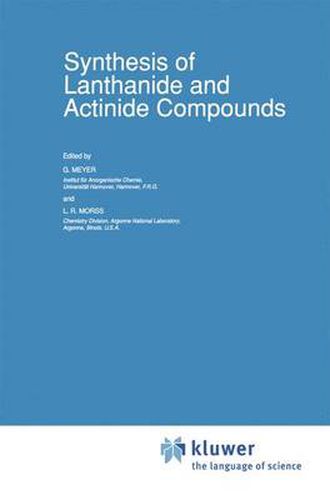Readings Newsletter
Become a Readings Member to make your shopping experience even easier.
Sign in or sign up for free!
You’re not far away from qualifying for FREE standard shipping within Australia
You’ve qualified for FREE standard shipping within Australia
The cart is loading…






This title is printed to order. This book may have been self-published. If so, we cannot guarantee the quality of the content. In the main most books will have gone through the editing process however some may not. We therefore suggest that you be aware of this before ordering this book. If in doubt check either the author or publisher’s details as we are unable to accept any returns unless they are faulty. Please contact us if you have any questions.
The history of the rare earths has entered its third century; trans uranium elements are now a half century old. Both the lanthanide and actinide ele- ments, 30 elements altogether, are f elements, meaninj that their metallic 2 1 1 electronic configurations are typically 6s 5d 4f and 7s 6d 5f respectively. To an elementary approximation as summarized in the ‘average inorganic chemistry textbook, these configurations cause their chemistry to be described by the trivalent state accompanied by less interesting effects such as the lanthanide contraction. However, the discovery of divalent and tetravalent lanthanides and di- to seven-valent actinides hinted at the existence of more interesting although still classic solid-state and coor- dination chemistry. Metallic halides and chalcogenides and electron-poor cluster compounds have been the outgrowth of many synthetic efforts during the past 25 years or so. These days, one can say that the lan- thanides and actinides are not at all boring; the fascination arises from every element being an individual, having its own chemistry.
$9.00 standard shipping within Australia
FREE standard shipping within Australia for orders over $100.00
Express & International shipping calculated at checkout
This title is printed to order. This book may have been self-published. If so, we cannot guarantee the quality of the content. In the main most books will have gone through the editing process however some may not. We therefore suggest that you be aware of this before ordering this book. If in doubt check either the author or publisher’s details as we are unable to accept any returns unless they are faulty. Please contact us if you have any questions.
The history of the rare earths has entered its third century; trans uranium elements are now a half century old. Both the lanthanide and actinide ele- ments, 30 elements altogether, are f elements, meaninj that their metallic 2 1 1 electronic configurations are typically 6s 5d 4f and 7s 6d 5f respectively. To an elementary approximation as summarized in the ‘average inorganic chemistry textbook, these configurations cause their chemistry to be described by the trivalent state accompanied by less interesting effects such as the lanthanide contraction. However, the discovery of divalent and tetravalent lanthanides and di- to seven-valent actinides hinted at the existence of more interesting although still classic solid-state and coor- dination chemistry. Metallic halides and chalcogenides and electron-poor cluster compounds have been the outgrowth of many synthetic efforts during the past 25 years or so. These days, one can say that the lan- thanides and actinides are not at all boring; the fascination arises from every element being an individual, having its own chemistry.